German actress and comedian Ingrid Steeger (1947-2023) died yesterday, 22 December 2023. She was 76. Steeger started her career in the soft sex films that were all the rage in Europe during the late 1960s and early 1970s. In 1973, she became famous as a Marilyn Monroe-like funny and sexy blonde in the TV comedy show Klimbim.
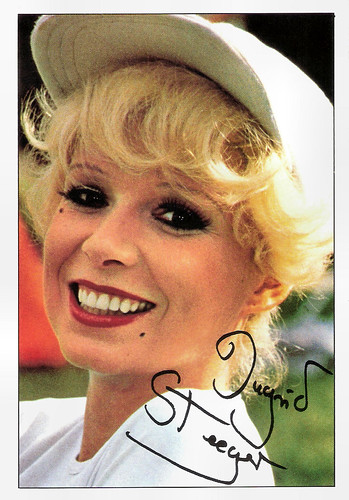
German autograph card by Bravo.
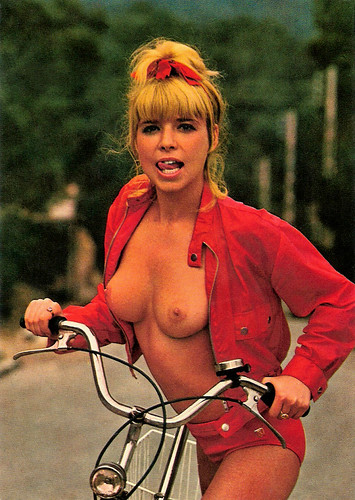
German postcard by Krüger, no. 900/400.
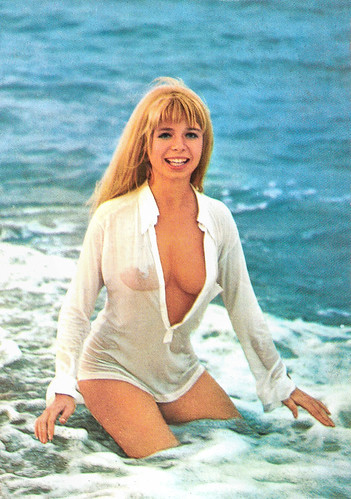
German postcard by Krüger, no. 900/399. Sent by mail from France to Germany in 1971.

West German autograph card by Pop magazine.

German autograph card, signed in 2012.
Ingrid Steeger was born as Ingrid Anita Stengert in 1947 in Berlin. She was the third child of Kurt and Käthe Stengert. After school, she worked as a secretary when she was discovered by photographer Frank Quade. Soon pinup photos of her appeared in numerous men's magazines, especially SEXY, where even today she is the girl with the most cover shots.
In the same year, she played her first small film role as a party girl in Pierre Gaspard-Huit's society study Karriere/Career (1966). In 1968, she adopted the stage name Steeger and was crowned 'Miss Film Festival' in a club on the fringes of the Berlinale. She appeared in the Edgar Wallace crime films Der Gorilla von Soho/Gorilla Gang (Alfred Vohrer, 1968) and Die Tote aus der Themse/Angels of Terror (Harald Philipp, 1971). The popularity of the Wallace series was waning and Steeger found more employment in a new, trendy genre, sexploitation.
Her first erotic comedy was Rat' mal, wer heut bei uns schläft...?/Guess Who's Sleeping with Us Tonight? (Alexis Neve, 1969) with Andrea Rau. Not wanting to use her real name, because her father objected, and not yet having decided on a stage name, her first film billed her as Ingrid Stengel. Next followed Ich - Ein Groupie/Me, a Groupie (Erwin C. Dietrich, 1970) in which she played the lead as a groupie travelling across Europe with rock bands and hippies. Christopher Underwood at IMDb: "Splendidly lurid sexploitation featuring a lovely Ingrid Steeger who wears sexy clothes now and again but not too often. A surprisingly large amount of time is spent over the preparation and administration of various drugs and the music and musicians authentic enough."
A huge box office hit in European cinemas was the 'sex report' film Schulmädchen-Report: Was Eltern nicht für möglich halten/Schoolgirl Report Part 1: What Parents Don't Think Is Possible (Ernst Hofbauer, 1970). The film is a pseudo-documentary loosely based on the non-fictional book 'Schulmädchen-Report' by sexologist Günther Hunold, published the same year. The book presented interviews with twelve teenage girls on their sexual lives. Schulmädchen-Report topped the German cinema charts for weeks in 1970 and became the first in a series that would last thirteen titles until 1980.
Steeger appeared in part 4 and 5, Schulmädchen-Report 4 – Was Eltern oft verzweifeln läßt/Schoolgirl Report Part 4: What Drives Parents to Despair (Ernst Hofbauer, 1972) and Schulmädchen-Report 5 – Was Eltern wirklich wissen sollten/Schoolgirl Report Part 5: What All Parents Should Know (Walter Boos, Ernst Hofbauer, 1973), but also in several variations like Ehemänner-Report/Freedom for Love (Harald Philipp, 1971), Hochzeitsnacht-Report/Wedding Night Report (Hubert Frank, 1972), Krankenschwestern-Report/Nurses Report (Walter Boos, 1972) and Hausfrauenreport international/Housewives on the Job (Ernst Hofbauer, 1973). Around 20 years later, she emphasised in Emma magazine how much she detested these films: "I find it disgusting that someone grabbed my breasts and that I did it for money - I was selling myself back then."
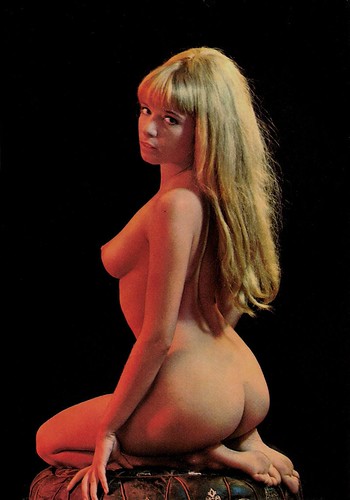
German postcard by Krüger, no. 900/400.
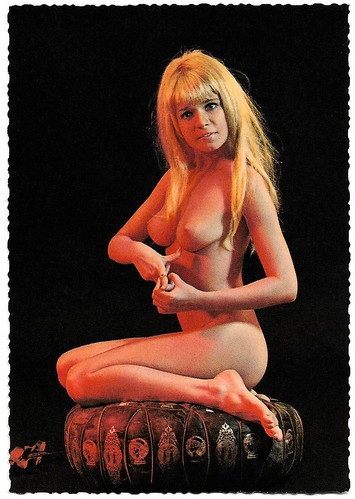
German postcard by Krüger, no. 900/400.

German postcard by Krüger.
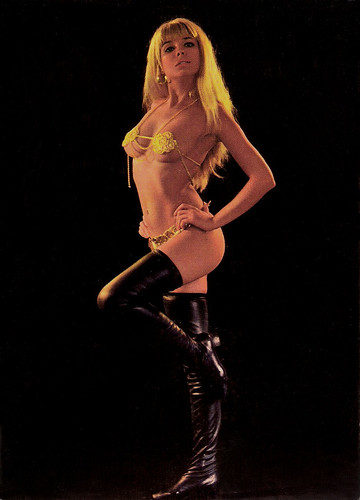
German postcard by Krüger.
In between all these soft sex films, Ingrid Steeger also played parts in TV films and series like in an episode of the popular Krimi series Der Kommissar/The Police Inspector (1973) with Erik Ode and Fritz Wepper. She had her breakthrough when she starred in the TV comedy show Klimbim (1973-1979), a German version of the American show Rowan and Martin's Laugh-In. She proved to be an excellent comedienne. Steeger was the blonde Gabi Klimbim with a gap in her teeth, Elisabeth Volkmann was her mother, Horst Jüssen was her stepfather, Wichart von Roëll was her grandfather and - in alternating roles - Peer Augustinski. Steeger was a huge success as the Marilyn Monroe-like funny and sexy Gabi, who often went topless. The series, created by Michael Pfleghar, was a huge cult hit, and the sex was one of the reasons. It was rather unusual and daring for a prime-time national TV programme.
Stefan Kahrs at IMDb: “Another invention was to use a sitcom element in the show, the Klimbim family. This sitcom within the show could perhaps be described as a cross between the Bundy family in Married... with Children and the students in The Young Ones (1982). In other words, you watched in a mixture of amusement and horror, relieved that nobody like that would live anywhere near you. Although the characters in that sitcom were all outrageous caricatures, it still gave the show's regulars plenty of opportunity to show off their comedic skills.”
Steeger won several TV awards, including the Goldene Kamera by TV magazine Hörzu in 1977, the Bravo Otto in gold in 1978 (voted by the readers of Germany's biggest teen magazine Bravo) and the Bambi award in 1990. With Iris Berben, she also co-starred in the TV miniseries Zwei himmlische Töchter/Two Heavenly Daughters (Michael Pfleghar, 1978) as two nightclub dancers who inherit a 1930s aeroplane. Then she flopped badly with a third series directed by Pfleghar, Susi (Michael Pfleghar, 1980-1981).
She went to France to live with her French actor-friend Jean-Paul Zehnacker, who had co-starred with her in Susi. But they soon separated. Ingrid returned to Germany to become a mature, serious actress, in the vein of her idols Shirley MacLaine or Goldie Hawn, but the public wouldn't let her. Guest appearances in many German TV series followed. She also played in a few films, such as André schafft sie alle/Andre Handles Them All (Peter Fratzscher, 1985) with Franco Nero, and Paul is Dead (Hendrik Handloegten, 2000) about the urban legend that Paul McCartney died early and the public had not been informed at all.
Her last film was Goldene Zeiten/Golden Times (Peter Tworwarth, 2006) starring Dirk Benedict. In recent years she has concentrated on theatre and played mostly in boulevard comedies. She also wrote her memoirs, 'Und find es wunderbar: Mein Leben' (And Find it Wonderful – My Life). About her difficult relationships with men, she wrote the book 'Meine MANNschaft' (2004). Steeger was married twice, first to cameraman Lothar E. Stickelbrucks (1973–1975) and later to Red Indian Dakota Tom LaBlanc (1992–1995). Since 2010, she lived reclusively in Munich with her dachshund Eliza Doolittle. In 2020, she was struck by cardiac arrest and went to live with her sister Jutta in Bad Hersfeld, Hesse. In 2022, Steeger survived another cardiac arrest and also corona but in 2023, she died in a hospital in Bad Hersfeld, Germany, at the age of 76.
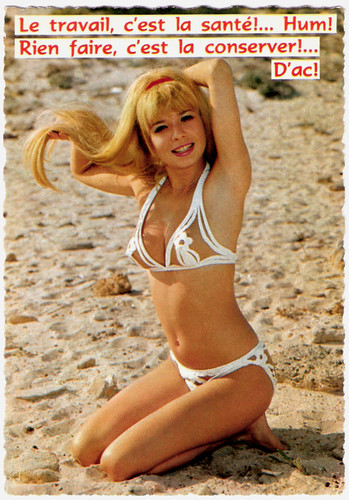
French postcard by Editions Chapeau, Nantes / S.P.A.D.E.M., Paris, 1974, printed in Italy by Cecami. Captions: "Le travail c'est la santé!... Hum! Rien faire, c'est la conserver!... D'ac!" and at the flipside "En vacances".

German postcard by Krüger.

German autograph card.

West German autograph card, 1997. photo: Peter W. Engelmeier.
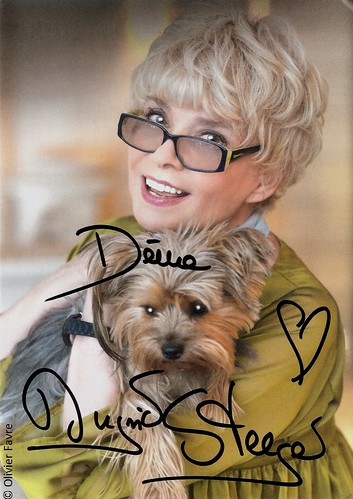
German promotion card by Bastei Lübbe for Ingrid Steeger's autobiography 'Und find es wunderbar: Mein Leben'. Photo: Olivier Favre.
Sources: Ulrich Lobjinski (IMDb), Stefan Kahrs (IMDb), Christopher Underwood (IMDb), Filmportal (German), Wikipedia (English, Dutch and German), and IMDb.

German autograph card by Bravo.

German postcard by Krüger, no. 900/400.

German postcard by Krüger, no. 900/399. Sent by mail from France to Germany in 1971.

West German autograph card by Pop magazine.

German autograph card, signed in 2012.
The girl with the most cover shots
Ingrid Steeger was born as Ingrid Anita Stengert in 1947 in Berlin. She was the third child of Kurt and Käthe Stengert. After school, she worked as a secretary when she was discovered by photographer Frank Quade. Soon pinup photos of her appeared in numerous men's magazines, especially SEXY, where even today she is the girl with the most cover shots.
In the same year, she played her first small film role as a party girl in Pierre Gaspard-Huit's society study Karriere/Career (1966). In 1968, she adopted the stage name Steeger and was crowned 'Miss Film Festival' in a club on the fringes of the Berlinale. She appeared in the Edgar Wallace crime films Der Gorilla von Soho/Gorilla Gang (Alfred Vohrer, 1968) and Die Tote aus der Themse/Angels of Terror (Harald Philipp, 1971). The popularity of the Wallace series was waning and Steeger found more employment in a new, trendy genre, sexploitation.
Her first erotic comedy was Rat' mal, wer heut bei uns schläft...?/Guess Who's Sleeping with Us Tonight? (Alexis Neve, 1969) with Andrea Rau. Not wanting to use her real name, because her father objected, and not yet having decided on a stage name, her first film billed her as Ingrid Stengel. Next followed Ich - Ein Groupie/Me, a Groupie (Erwin C. Dietrich, 1970) in which she played the lead as a groupie travelling across Europe with rock bands and hippies. Christopher Underwood at IMDb: "Splendidly lurid sexploitation featuring a lovely Ingrid Steeger who wears sexy clothes now and again but not too often. A surprisingly large amount of time is spent over the preparation and administration of various drugs and the music and musicians authentic enough."
A huge box office hit in European cinemas was the 'sex report' film Schulmädchen-Report: Was Eltern nicht für möglich halten/Schoolgirl Report Part 1: What Parents Don't Think Is Possible (Ernst Hofbauer, 1970). The film is a pseudo-documentary loosely based on the non-fictional book 'Schulmädchen-Report' by sexologist Günther Hunold, published the same year. The book presented interviews with twelve teenage girls on their sexual lives. Schulmädchen-Report topped the German cinema charts for weeks in 1970 and became the first in a series that would last thirteen titles until 1980.
Steeger appeared in part 4 and 5, Schulmädchen-Report 4 – Was Eltern oft verzweifeln läßt/Schoolgirl Report Part 4: What Drives Parents to Despair (Ernst Hofbauer, 1972) and Schulmädchen-Report 5 – Was Eltern wirklich wissen sollten/Schoolgirl Report Part 5: What All Parents Should Know (Walter Boos, Ernst Hofbauer, 1973), but also in several variations like Ehemänner-Report/Freedom for Love (Harald Philipp, 1971), Hochzeitsnacht-Report/Wedding Night Report (Hubert Frank, 1972), Krankenschwestern-Report/Nurses Report (Walter Boos, 1972) and Hausfrauenreport international/Housewives on the Job (Ernst Hofbauer, 1973). Around 20 years later, she emphasised in Emma magazine how much she detested these films: "I find it disgusting that someone grabbed my breasts and that I did it for money - I was selling myself back then."

German postcard by Krüger, no. 900/400.

German postcard by Krüger, no. 900/400.

German postcard by Krüger.

German postcard by Krüger.
Klimbim
In between all these soft sex films, Ingrid Steeger also played parts in TV films and series like in an episode of the popular Krimi series Der Kommissar/The Police Inspector (1973) with Erik Ode and Fritz Wepper. She had her breakthrough when she starred in the TV comedy show Klimbim (1973-1979), a German version of the American show Rowan and Martin's Laugh-In. She proved to be an excellent comedienne. Steeger was the blonde Gabi Klimbim with a gap in her teeth, Elisabeth Volkmann was her mother, Horst Jüssen was her stepfather, Wichart von Roëll was her grandfather and - in alternating roles - Peer Augustinski. Steeger was a huge success as the Marilyn Monroe-like funny and sexy Gabi, who often went topless. The series, created by Michael Pfleghar, was a huge cult hit, and the sex was one of the reasons. It was rather unusual and daring for a prime-time national TV programme.
Stefan Kahrs at IMDb: “Another invention was to use a sitcom element in the show, the Klimbim family. This sitcom within the show could perhaps be described as a cross between the Bundy family in Married... with Children and the students in The Young Ones (1982). In other words, you watched in a mixture of amusement and horror, relieved that nobody like that would live anywhere near you. Although the characters in that sitcom were all outrageous caricatures, it still gave the show's regulars plenty of opportunity to show off their comedic skills.”
Steeger won several TV awards, including the Goldene Kamera by TV magazine Hörzu in 1977, the Bravo Otto in gold in 1978 (voted by the readers of Germany's biggest teen magazine Bravo) and the Bambi award in 1990. With Iris Berben, she also co-starred in the TV miniseries Zwei himmlische Töchter/Two Heavenly Daughters (Michael Pfleghar, 1978) as two nightclub dancers who inherit a 1930s aeroplane. Then she flopped badly with a third series directed by Pfleghar, Susi (Michael Pfleghar, 1980-1981).
She went to France to live with her French actor-friend Jean-Paul Zehnacker, who had co-starred with her in Susi. But they soon separated. Ingrid returned to Germany to become a mature, serious actress, in the vein of her idols Shirley MacLaine or Goldie Hawn, but the public wouldn't let her. Guest appearances in many German TV series followed. She also played in a few films, such as André schafft sie alle/Andre Handles Them All (Peter Fratzscher, 1985) with Franco Nero, and Paul is Dead (Hendrik Handloegten, 2000) about the urban legend that Paul McCartney died early and the public had not been informed at all.
Her last film was Goldene Zeiten/Golden Times (Peter Tworwarth, 2006) starring Dirk Benedict. In recent years she has concentrated on theatre and played mostly in boulevard comedies. She also wrote her memoirs, 'Und find es wunderbar: Mein Leben' (And Find it Wonderful – My Life). About her difficult relationships with men, she wrote the book 'Meine MANNschaft' (2004). Steeger was married twice, first to cameraman Lothar E. Stickelbrucks (1973–1975) and later to Red Indian Dakota Tom LaBlanc (1992–1995). Since 2010, she lived reclusively in Munich with her dachshund Eliza Doolittle. In 2020, she was struck by cardiac arrest and went to live with her sister Jutta in Bad Hersfeld, Hesse. In 2022, Steeger survived another cardiac arrest and also corona but in 2023, she died in a hospital in Bad Hersfeld, Germany, at the age of 76.

French postcard by Editions Chapeau, Nantes / S.P.A.D.E.M., Paris, 1974, printed in Italy by Cecami. Captions: "Le travail c'est la santé!... Hum! Rien faire, c'est la conserver!... D'ac!" and at the flipside "En vacances".

German postcard by Krüger.

German autograph card.

West German autograph card, 1997. photo: Peter W. Engelmeier.

German promotion card by Bastei Lübbe for Ingrid Steeger's autobiography 'Und find es wunderbar: Mein Leben'. Photo: Olivier Favre.
Sources: Ulrich Lobjinski (IMDb), Stefan Kahrs (IMDb), Christopher Underwood (IMDb), Filmportal (German), Wikipedia (English, Dutch and German), and IMDb.
Oh those German gals
ReplyDeleteAch der lieber
ReplyDelete